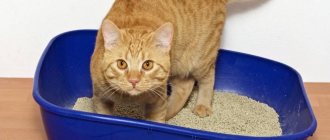Very often, a signal of a disease is atypical symptoms, which are not always easy to spot. However, if blood appears in the kitten’s urine, this means that it has a number of abnormalities or pathology that requires urgent treatment. Otherwise, there is a risk of worsening the disease and even death, which is not uncommon with such rather serious symptoms.
For any abnormalities or signs of illness, you need to call a veterinarian at home. He will conduct a detailed diagnosis and examination of the pet, after which he will prescribe a course of treatment. Any express tests are carried out within fifteen minutes during the departure, so you do not have to waste extra time and money waiting and getting results during the next departure.
Signs of hematuria in a cat
“Hematuria” is literally translated from Latin as “bloody urine” (“hema” - blood, “urina” - urine).
Indeed, one should be wary if even the slightest traces of blood are detected in cat urine - this cannot in any way be considered a manifestation of the norm and clearly indicates that pathological processes are occurring in the cat’s body. The problem is that detecting blood in the urine in the initial stages of the disease can be very difficult - it often cannot be seen with the naked eye. Most owners notice signs of hematuria, when the problem has developed, there is a lot of blood and the urine has acquired a pronounced color:
- pink;
- scarlet;
- reddish;
- brown.
Sometimes, however, the disease manifests itself immediately and in visible signs - these can be dark red spots, clots in the urine, or even a bloody puddle in the tray. In order not to miss the moment, it is necessary to pay attention not only to obvious, but also to accompanying symptoms, and as soon as you suspect something is wrong, immediately consult a doctor.
Change in urine color due to medication
Some drugs are excreted from the body by the kidneys along with urine. Some of them are capable of changing its normal color:
- a red color may occur when taking the antibiotic rifampicin, antipyretics - amidopyrine and antipyrine, as well as the laxative purgen, which contains phenolphthalein;
- Pink color of urine can be caused by long-term use of high doses of acetylsalicylic acid (aspirin);
- a dark brown color may occur during treatment with phenyl salicylate;
- the blue-green color is caused by triamterene, which is used to enhance renal blood flow;
- Orange urine color occurs when taking the vitamin riboflavin.
Red urine in a cat indicates a serious illness
The appearance of blood in the urine of cats is called hematuria in veterinary practice. If red urine is detected in a cat, the owner of the animal should contact a veterinary clinic to conduct a full examination and identify the causes of the problem.
Detecting red urine in a cat is not difficult for most pet owners, because if the animal goes to the cat litter box, the litter immediately acquires a characteristic color, and in addition, even if the need was relieved in the wrong place, the impurities will also be clearly visible. Difficulties in detecting hematuria exist only in cases where animals are accustomed to going outside, where they have the opportunity to go to the toilet.
It is worth noting that the most common cause of hematuria in cats is urolithiasis. Many animal owners feed their pets with low-quality food, while unknowingly limiting access to water, which often leads to the development of urolithiasis.
Among other things, surgical interventions, including castration of cats, can be a prerequisite for the appearance of urolithiasis and bloody discharge in the urine. Timely detection of urolithiasis and targeted medical, surgical and physiotherapeutic therapy makes it possible to restore health to a sick animal and significantly increase its life expectancy.
In rare cases, a cat's urine may be red as a result of an injury. The thing is that cats are mobile creatures, so they can get under the feet of their owners, and also fall from great heights, which can lead to injury to the kidneys or organs of the urinary system.
When your cat's urine is red, the problem may be more serious than it seems at first glance. Cats, like people, are susceptible to the development of cancer, so when a malignant tumor develops in the kidneys or excretory tract, hematuria is often observed. In this case, the only option is surgery.
In addition, the appearance of hematuria in cats may be associated with severe poisoning with rat poison or other substances that are anticoagulants. Rat poisoning typically occurs when a cat catches and eats a rat or mouse that has been poisoned. If the problem lies in poisoning, only a timely visit to the veterinarian will save the animal’s life.
In a kitten, hematuria may be rooted in congenital anomalies of the urinary system. With this option, the treatment prognosis, as well as the hematuria treatment strategy itself, largely depends on the developmental anomalies that the animal has. Sometimes parasitic infestation can cause hematuria in cats.
The thing is that when parasites stick to the walls of the urinary tract or live in the kidneys, they can injure blood vessels. In the vast majority of cases, eliminating parasites with properly prescribed antiparasitic drugs can reliably solve the problem of blood in the urine of an animal.
Some infectious diseases can also cause hematuria in cats. For example, a disease such as leptospirosis often causes blood to appear in the urine. In addition, the appearance of hematuria in cats may be associated with severe urethritis, cystitis and pyelitis.
Timely consultation with a doctor and the prescription of complex therapy can eliminate the root cause of the appearance of blood in the urine and relieve the animal from the unpleasant sensations it experiences due to damage to certain organs and systems.
Blood in a cat’s urine can be a sign of many diseases, which can only be accurately determined at an appointment with a veterinarian. However, primary diagnosis can also be made based on careful observations of the pet - in any case, these data are very important for the doctor and will help him quickly recreate the full picture of the situation.
The cat's discharge should be transparent and have a yellow-orange tint. If the owner finds blood in the cat’s urine, this indicates an inflammatory process or other problems in the animal’s body that need to be eliminated. First of all, it is necessary to find out why there was blood in his urine, and then begin treatment.
In order to be able to control the color of the cat’s excrement, it is worth teaching him to pee on an empty tray or choose a light-colored litter. Pink, brown or red urine with possible blood clots indicates problems with the animal's health. Deep-colored urine results from an excess of red blood cells, which indicates inflammation in the body.
In addition to the fact that there is blood in the cat’s urine, hematuria may have the following symptoms:
- lack of appetite;
- lethargy and apathy;
- increased body temperature;
- the animal urinates past the tray onto furniture and carpeting;
- When a cat pees, nervousness is observed in its behavior as a result of painful urination.
Red urine may be the result of your cat eating carrots or beets. In this case, you don't need to do anything. The most reliable method for determining the presence of blood in urine is a laboratory test for red blood cells.
Collecting urine for analysis
Red discharge in cats indicates serious illnesses that may require long-term treatment. The first thing the animal owner needs to do in this situation is to collect urine for analysis. After this, you need to show the cat to the veterinarian, and send the finished material for research. For laboratory tests, urine collected no earlier than 3-4 hours ago is suitable.
Rules for collecting analysis:
- The tray must first be rinsed with hot water;
- The filler is either removed altogether, or small sea pebbles are placed at the bottom of the pot;
- The finished urine is poured into a clean container and submitted for analysis no later than 4 hours after collection;
- The animal must be fed no later than 6 hours before the test is taken.
Causes of blood in urine
Blood can enter the urine either directly from the kidneys or from other organs of the urinary system. Since hematuria is not an independent disease, but only an indicative symptom of a disease or injury, it is urgent to determine its causes and do everything possible to eliminate them.
Blood in the urine is most often a consequence of kidney pathology
Hematuria may have the following causes:
- kidney and urinary tract diseases;
- pathologies of the bladder;
- the presence of stones in the kidneys or bladder;
- inflammatory processes of the genitourinary system;
- various infections;
- reproductive problems;
- injuries;
- endoparasites;
- intoxication, including drug intoxication.
Falls from heights are not as safe for cats as is commonly believed - they can lead to serious injuries.
Diagnosis of hematuria in a veterinary clinic
When contacting a veterinary clinic, the doctor must prescribe a list of laboratory tests necessary to make an accurate diagnosis. The main diagnostic tests are:
- general urinalysis (allows you to determine the number of blood clots in urine and changes in general composition);
- bacterial culture of urine on nutrient media (makes it possible to determine the type of infectious agent for precise selection of medications);
- general and biochemical blood test (necessary to confirm inflammatory processes, and also allows you to assess the functioning of the renal structures).
Additional tests for hematuria are:
- coagulogram (determination of blood clotting factors);
- X-ray examination or ultrasound diagnostics of the abdominal organs (allows you to detect stones due to urolithiasis, as well as tumor processes and possible anomalies in the structure of the urinary system);
- cytoscopy (a study to detect pathological processes in the bladder);
- histology and biopsy (if necessary to determine the type of tumor).
Why is this happening
Blood in a cat’s urine is an indicator of a serious condition of the body or a disease, the development of which could be provoked by certain reasons. The veterinarian will identify them during laboratory and computer examinations. As a rule, hematuria develops as a result of various infections, diseases and injuries.
The main causes of hematuria leading to serious consequences:
- the presence of bacterial infections and diseases of the genitourinary system, such as urolithiasis, cystitis, pyelitis or urethritis;
- intrauterine anomalies in the development of internal organs, especially the kidneys;
- severe damage to the kidneys and bladder by worms and other parasites;
- damaged internal organs as a result of impacts, injuries or falls from a height;
- poisoning by poor-quality food, poisons, medications;
- hypothermia or overheating of the body;
- the presence of a malignant tumor;
- diseases of the cardiovascular system.
Determining the cause of blood in the urine is of great importance, since further treatment and the speed of recovery of the animal depend on this.
Depending on the causes, the following types of hematuria are distinguished:
- Renal parenchymal hematuria is a consequence of kidney problems. These can be diseases of varying degrees of complexity, injuries, inflammations, infections, tumors and other anomalies.
- Hematuria is a pathology of the urinary tract - its causes are the presence of bacteria in the urine, infections of the bladder, urethra, ureter, as well as tumors, injuries, inflammation and other problems in the functioning of these organs.
- Hematuria from diseases of the genital tract - darkening of urine with vaginal discharge in cats or inflammation of the prostate in cats.
- Hematuria as a result of a systemic disease - pink or red urine in this case appears after diseases of the liver, cardiovascular system, or other pathologies such as overheating, hypothermia, excessive physical exertion.
Regardless of the type of hematuria, treatment should be carried out in a hospital or at home exclusively under the supervision of a doctor.
Diagnostics
To identify the cause of the presence of blood in urine and make an accurate diagnosis on the basis of which treatment will be prescribed, the veterinarian must conduct a thorough examination. First, a visual inspection of the cat is carried out. If the owner was unable to first collect urine for analysis, this can be done in a clinic using a catheter.
Examination methods and tests for hematuria:
- General urine analysis - indicates an excess of red blood cells and other dangerous impurities in the cat’s excretions and the presence of an inflammatory process;
- Biochemical blood test - indicates problems in the kidneys;
- Coagulogram – determines the level of blood clotting;
- Sensitivity and urine culture - helps to determine the presence of infection in the urine and select the right antibiotic;
- Ultrasound of the abdominal cavity - determines the presence of tumors, stones and infections;
- X-ray with contrast - allows you to detect anomalies, tumors and stones of the genitourinary system;
- X-ray of the abdominal cavity - indicates the presence of stones in the organs of the urinary system;
- Cystoscopy – allows you to examine the condition of the urethra and bladder from the inside;
- Analysis of stones or histology of a removed tumor (if detected) - based on the data from these tests, the doctor prescribes a specific treatment.
General urine analysis (with sediment microscopy)
IMPORTANT!
The information in this section cannot be used for self-diagnosis and self-treatment.
In case of pain or other exacerbation of the disease, diagnostic tests should be prescribed only by the attending physician. To make a diagnosis and properly prescribe treatment, you should contact your doctor. We remind you that independent interpretation of the results is unacceptable; the information below is for reference only.
General urine analysis (with sediment microscopy): indications for use, rules for preparing for the test, interpretation of the results and normal indicators. Indications for the purpose of the study
A general urine test refers to routine laboratory tests aimed primarily at screening for diseases of the urinary system, since pathological processes in the kidneys and urinary tract affect the properties of urine.
With this simple diagnostic test, infectious and inflammatory diseases such as glomerulonephritis
(inflammation of the renal glomeruli),
pyelonephritis
(inflammation of the renal pelvis),
cystitis
(inflammation of the bladder).
Microscopy of urine sediment allows one to suspect injury or infarction of the kidney, urolithiasis, some neoplasms, renal amyloidosis (a systemic disease in which a specific insoluble protein is deposited in the kidneys, which impairs the functioning of the organ).
In addition to diagnosing kidney and urinary tract diseases, the results of a general urine test with sediment microscopy can provide information about your general health.
Urine is formed as a result of ultrafiltration of blood plasma through the glomeruli of the kidneys. With the development of various diseases, pathological metabolic products enter the blood and are excreted from the body, including through the kidneys.
Preparation for the procedure
Preparation for a general urine test begins the day before the collection of biomaterial. Certain foods, the amount of fluid you drink, taking medications and dietary supplements, and intense physical activity can distort the results of the study.
The day before collecting urine, you should avoid foods that can affect the color of your urine: for example, beets and blueberries give your urine a reddish tint; consuming large amounts of carrots or carotene supplements may change the color of your urine to orange.
On the eve of urine collection, it is not recommended to drink alcohol, coffee, dietary supplements or strong tea. If possible, you should limit your intake of diuretics (diuretics). It is necessary to exclude serious physical activity, as well as visiting a bathhouse or sauna.
Women during menstruation are not recommended to donate urine for testing, since even a small amount of blood will significantly distort the test result.
You should warn your doctor about the medications you are taking, as well as about invasive examinations (for example, cystoscopy) on the eve of the test.
Method of collecting urine for general analysis
- It is necessary to prepare in advance a disposable sterile container for collecting urine (can be purchased at a pharmacy or taken from the INVITRO medical office).
- Before collecting urine, hygienic treatment of the external genitalia should be carried out, without using antibacterial and disinfectants.
For children, you need to adhere to the following rules: girls are washed from front to back (from the pubis to the tailbone) so that bacteria that populate the intestines do not enter the urinary tract. Only wash the skin with soap, since contact with mucous membranes causes irritation, dryness and itching. In boys, the glans penis is fused with the foreskin (physiological phimosis), so it is not recommended to forcefully open the glans penis, as this leads to trauma to the delicate tissue. You just need to slightly pull the skin and rinse with water, but it is unacceptable to direct a stream of water into the opening of the urethra. - For general analysis, as a rule, the first morning urine sample is collected. First, release a small amount of urine into the toilet, then, without interrupting urination, place a container and collect approximately 50 ml of urine. In this case, it is necessary to ensure that the container does not touch the skin and mucous membranes.
- After collecting urine, close the container tightly with a screw cap.
- Special urinals have been developed for newborns and infants. You should not use urine squeezed out of a diaper or diaper - the results will be unreliable, since the diaper is a kind of filter for microscopic elements of urine, which are counted during the study.
- When taking the test during the day, it is not recommended to drink large amounts of water, tea, coffee or diuretics to stimulate urination.
The turnaround time for a general urine test is usually 1 business day. What may affect the results
Factors that may distort the results of the study:
- Violation of hygiene procedures and urine collection techniques.
- Drinking large or small amounts of water.
- Consuming foods, medications, or dietary supplements that change the color of urine.
- Menstruation.
- High blood pressure.
- Intense physical and psycho-emotional stress on the eve of urine collection.
- Visiting a bathhouse, sauna, hypothermia.
- Carrying out invasive procedures on the urinary tract a week before the test.
take a general urine test
at the nearest INVITRO medical office. A list of offices where biomaterial is accepted for laboratory research is presented in the “Addresses” section.
Urine examination includes the study of physical and chemical properties, as well as microscopy of sediment.
Physical properties: quantity, color, odor, transparency, relative density (specific gravity), urine reaction (pH).
Chemical properties: determination of protein, glucose, ketone bodies, urobilinogen, bilirubin, hemoglobin, nitrites, leukocyte esterase.
Microscopy: identification of erythrocytes, leukocytes, cells of flat, transitional and renal epithelium, cylinders, crystals, mucus, bacteria, fungi.
Normal indicators
| Index | Result |
| Quantity | 50 ml |
| Color | Colorless, light yellow, straw yellow, yellow, amber yellow |
| Smell | Odorless or non-specific |
| Transparency | Transparent |
| Relative density of urine (specific gravity) | 1003-1035 |
| Urine reaction (pH) | 5.0-8.0 (in children under 1 month – 5.0-7.0) |
| Protein | > 0.140 g/l |
| Glucose | > 2.8 mmol/l |
| Ketone bodies | > 1 mmol/l |
| Urobilinogen | > 34 mmol/l |
| Bilirubin | Not detected |
| Hemoglobin | Not detected |
| Leukocyte esterase | Not detected |
| Nitrites | Not detected |
| Red blood cells | Up to 2 cells per field of view |
| Leukocytes | Up to 5 cells in field of view |
| Epithelium | Up to 5 squamous epithelial cells per field of view |
| Cylinders | Not detected |
| Crystals | Little or no detectable amounts of urates, calcium oxalates, amorphous phosphates |
| Slime | In small quantities |
| Bacteria | Not detected |
| Fungi | Not detected |
Interpretation of indicators
It should be remembered that a general urine test is a screening test, so its results can be used when prescribing other laboratory and instrumental examinations to clarify the diagnosis.
Urine color
depends on the concentration of substances dissolved in it and ranges from transparent to amber-yellow.
Under normal conditions, urine is colored by products of pigment metabolism (in particular, bilirubin): urochromes, urobilinoids and other substances. When the level of bilirubin in the blood increases, more of it enters the urine and gives it a rich brownish or even greenish-brown color. When erythrocytes (red blood cells), myoglobin (the main protein of muscle tissue) or hemoglobin (the protein contained in red blood cells) enter the urine, its color changes to brownish-red and takes on the appearance of “meat slop.” Taking vitamins and nitrofuran drugs can give urine a lemon-yellow to orange color. When there are a large number of leukocytes (white blood cells), the urine becomes milky in color (a condition called pyuria).
Transparency.
Under normal conditions, urine is clear. Its cloudiness can be caused by the presence of salts, crystals, cellular elements (erythrocytes, leukocytes).
Smell
. Normally, urine has a weak, non-specific odor. The appearance of an ammonia odor may be a sign of a bacterial infection; a peculiar fruity odor (“rotting apples”) appears with an increase in the concentration of ketone bodies (which most often indicates diabetes mellitus - a disorder of glucose metabolism).
Relative density of urine
, or specific gravity, is determined using a urometer. The relative density of urine gives an idea of the concentrating ability of the kidneys and the dilution function, which are reduced, like the relative density of urine, in renal failure.
Urine reaction (pH)
- a pH value that reflects the ability of the kidneys to maintain the acid-base balance of the body. The kidneys are involved in the excretion of hydrogen ions and bicarbonates, maintaining a constant blood pH. The pH value of urine is greatly influenced by diet, metabolic characteristics, infectious and inflammatory processes in the kidneys and urinary tract.
Protein
in urine is a significant marker in the diagnosis of diseases of the kidneys, urinary tract and cardiovascular system; it is also important in the diagnosis of gestosis, a severe complication of pregnancy. The appearance of protein in the urine is called proteinuria. Normally, urine does not contain protein because the kidney filter prevents the release of protein molecules from the blood into the urine. There are several causes of proteinuria.
- Prerenal causes: intense physical and psycho-emotional stress, heart failure, hypertension, fever, gestosis during pregnancy, nephroptosis, forced prolonged standing (often with hairdressers, surgeons, military personnel), injuries, disturbance of the protein composition of blood plasma.
- Renal causes: glomerular damage (glomerulonephritis and glomerulopathy), tubular damage, nephrosclerosis.
- Postrenal causes: infectious and inflammatory processes in the urinary tract, neoplasms.
Urine glucose.
The appearance of glucose in the urine depends on its concentration in the blood. Normally, glucose is completely reabsorbed from primary urine into the bloodstream if its concentration in the blood has not reached the “renal threshold” - 8.8-10.0 mmol/l. An increase in the level of glucose in the urine is possible due to a number of physiological reasons: errors in the diet (abuse of sweet foods, especially on the eve of collecting biomaterial), prolonged fasting, stress.
The appearance of glucose in the urine serves as a signal indicating pathology of the kidneys, endocrine system, side effects of drugs, poisoning, and complicated pregnancy.
Ketone bodies
are a non-specific indicator. The appearance of an increased amount of ketone bodies in the urine is the result of accelerated fat metabolism or decreased carbohydrate metabolism. Most often, an increase in their level is observed during fasting, fever, vomiting, alcohol intoxication and diabetes mellitus.
Urobilinogen
in urine increases in diseases of the intestines, liver, and hemolytic conditions (destruction of red blood cells).
Bilirubin
appears in the urine in case of liver pathologies, infectious diseases and pigment metabolism disorders.
Hemoglobin
is determined by a large number of red blood cells in the urine, with myositis, extensive injuries to muscle tissue, and thrombosis of muscle vessels.
Nitrites
detected in urine when pathogenic microflora is activated in the urinary system.
Increased red blood cell
observed in the following cases:
- Inflammatory diseases of the kidneys and urinary tract of infectious and non-infectious origin (glomerulonephritis, pyelonephritis, nephritis, cystitis, prostatitis, tuberculosis).
- Urolithiasis disease.
- Traumatic damage to the kidneys and urinary tract.
- Fever.
- Arterial hypertension with involvement of the renal vessels.
- Various blood coagulation disorders (hemophilia, thrombocytopenia, overdose of anticoagulants).
- Poisoning with benzene derivatives, aniline, snake venom, poisonous mushrooms, with intolerance to anticoagulant therapy.
- Tumor diseases of the genitourinary system.
The presence of leukocytes
in an amount of more than five cells in the field of view is noted in the following cases:
- Inflammatory diseases of the kidneys and urinary tract of infectious and non-infectious nature (glomerulonephritis, pyelonephritis, tubulointerstitial nephritis, cystitis, urethritis, tuberculosis).
- Urolithiasis disease.
- Renal transplant rejection.
- Systemic inflammatory diseases of non-infectious etiology (nephritis with systemic lupus erythematosus).
Epithelium
. There are cells of squamous, transitional and renal epithelium. A large amount of epithelium indicates increased desquamation of cells of the mucous membrane of the urinary tract when they are traumatized (by a stone, during an inflammatory process).
Cylinders
are formed in the tubules of the kidneys and allow us to determine the level of their damage. Most often found in glomerulonephritis.
Crystals
are detected in the sediment of salts at a certain pH of urine. Most often (though not always) found in patients with urolithiasis.
Slime
Normally, it can be found in urinary sediment in small quantities. An increase in mucus content may be associated both with an inflammatory process in the urinary tract and with errors made when collecting urine for research.
Bacteria and fungi
Normally they are not found in urinary sediment. Their presence indicates the presence of an infectious process in the kidneys and urinary tract or errors made during the collection of biomaterial for research.
If the general urine analysis indicators deviate from the norm, the following instrumental examinations and laboratory tests may be additionally prescribed:
- Comprehensive ultrasound of the urinary system (kidneys, ureters, bladder).
- Comprehensive ultrasound of the abdominal organs (liver, gall bladder, pancreas, spleen) for suspected diseases of the liver, gall bladder, etc.
- Study of biochemical blood test parameters (total protein, protein fractions, C-reactive protein, ALT, AST, LDH, GGT, total and direct bilirubin, cholesterol, creatinine, glucose, electrolytes: potassium, sodium, chlorine, calcium).
- Determination of fasting blood glucose, conducting an oral glucose tolerance test, studying the level of glycated hemoglobin for diagnosing diabetes mellitus.
- Urine culture for microflora and determination of sensitivity to antimicrobial drugs.
- Urine culture for microflora and determination of sensitivity to an extended range of antimicrobial drugs.
If the indicators of a general urine test change, you may need to consult a pediatrician or general practitioner, as well as a nephrologist.
Sources:
- Pediatric nephrology: Textbook / ed. P.V. Shumilova, E.K. Petrosyan, O.L. Chugunova. – M.: MEDpress-inform, 2021. – 616 p.: ill.
- Grebenev A.L. Propaedeutics of internal diseases: Textbook. – 5th ed., revised. and additional – M.: Medicine, 2001. – 592 p.: ill.
- Danilova L.A. Tests of blood, urine and other biological fluids at different age periods. – St. Petersburg: SpetsLit, 2014. – 111 p.
- .
IMPORTANT!
The information in this section cannot be used for self-diagnosis and self-treatment. In case of pain or other exacerbation of the disease, diagnostic tests should be prescribed only by the attending physician. To make a diagnosis and properly prescribe treatment, you should contact your doctor.
First aid for detecting blood in a cat's secretions
What to do in a situation where it is not possible to immediately show the animal to a veterinarian? The answer is simple: do not self-medicate. It is advisable to try to contact the doctor by telephone to receive detailed recommendations and, if necessary, prescribe a pain reliever. You also need to take actions that will help alleviate your pet’s condition.
First aid for hematuria:
- Provide the cat with peace by placing it in a dry, clean room;
- Provide access to clean water for drinking;
- Feed the animal liquid food;
- Give your cat a decoction of bearberry or parsley, which has disinfectant properties;
- Decoctions of juniper and horsetail will help reduce inflammation of the urinary tract.
It is unacceptable to treat an animal with antibiotics without a doctor's prescription. It is important to collect tests as early as possible and show the cat to a specialist.
Diagnostics
The effectiveness of treatment for hematuria in cats depends not only on timely access to the clinic, but also, of course, on how correctly the diagnosis was made. Therefore, it is very important to quickly apply all the necessary diagnostic methods, without refusing the tests offered to you - even the most experienced specialist will not be able to accurately determine the problem “by eye”.
Immediately upon arrival at the clinic, you must undergo a clinical examination by a veterinarian and do three mandatory tests:
- general urine analysis;
- Ultrasound;
- X-ray.
A blood test is the most important test for suspected hematuria
This is a quick and informative diagnosis, the results of which may require additional clarification:
- general blood analysis;
- blood biochemistry;
- urine reaction (pH);
- MRI;
- oncological tests.
Prognosis of feline hematuria
The veterinarian may need some information from you right before examining your cat to determine the cause of the disease. He will start by asking a few questions about the cat's behavior and health. Also, be sure to provide as much information as possible about the cat's pre-existing health conditions, injuries, and birth history that may have occurred. In addition, the doctor may also ask when symptoms first began and whether they have gotten worse recently.
Immediately after the veterinarian takes the medical history, he will examine the cat. You can also take a blood sample from your cat. A complete blood count, urinalysis, and biochemical profile may also be performed at this point. Additionally, the vet may also use a test strip to determine if the red spot in his urine is actually blood.
Some diagnostic tests, such as home x-rays, can also be used to diagnose the cause of hematuria in cats. An ultrasound may also be performed to provide further information, depending on what the doctor thinks the problem may be. Additionally, a contrast dye CT scan can also show a comprehensive picture of a cat's urinary tract. If your veterinarian palpates a mass in your cat's abdominal area, he or she may want to perform a biopsy. During this process, he could take a small sample of tumor tissue. This will be sent to a third party laboratory. This process is used to determine whether a tumor is malignant or benign.
Blood in a cat's urine: causes and treatment
After receiving the diagnostic results and visual examination, the veterinarian makes a diagnosis and prescribes the necessary treatment.
Methods to combat hematuria:
- The use of anti-inflammatory, antispasmodic and analgesic drugs;
- For advanced diseases, antibiotics are indicated, administered orally or intramuscularly;
- The use of vitamins, herbal tinctures and drugs to improve immunity;
- The use of drugs to stop bleeding;
- If there are stones in the urinary organs, the animal is prescribed a special diet;
- If the body is dehydrated, intravenous infusions of glucose and physiological solutions are indicated;
- For certain types of poisoning, a veterinarian may prescribe the use of vitamin K1.
- Stones, tumors and other neoplasms are removed surgically;
- If you have problems urinating, you may need to use a urinary catheter.
During pregnancy and after childbirth, the organs of the urinary system can often become inflamed and chronic diseases will worsen, but most medications in this case are contraindicated for use. Therefore, the prescription of treatment should be taken as seriously as possible, because not only the health of the cat, but also its unborn kittens depends on it.
The appearance of blood in a cat's urine is a very bad sign. This phenomenon indicates the development of an inflammatory process or other disease. What are the causes of blood in urine? How to properly treat hematuria? Let's look at these questions in this article.
Urine is produced by the kidneys. With it, all harmful substances, excess salts, vitamins, hormones and enzymes are released through the urinary system. Without this process, proper functioning of the body is impossible.
Normally, a cat's urine is clear and varies in color from light yellow to orange. It should be free of impurities, cloudiness and blood. The urine of a healthy cat does not have a strong odor.
How to collect urine for analysis
Before visiting the clinic, if possible, you should collect urine in a sterile jar for analysis. Of course, this procedure can also be done by a veterinarian using a catheter or a sterile syringe (cystocentesis), but such methods are quite traumatic, have a number of side effects and are used in emergency cases when the cat does not pass urine at all. In all other situations, urine can be collected at home.
Urine collection through a catheter is done in the clinic, but this method is traumatic and fraught with infection
To speed up the identification of the causes of illness, you need to independently prepare biomaterial for analysis. It is unlikely that you will be able to persuade your cat to pee directly into a clean jar - although some owners can even do this. Owners, taking into account the habits and character of their pets, use various methods of collecting urine:
- from the toilet, sink or bathtub - if the cat is used to peeing there;
- using a children's urine collector - this device is freely sold in pharmacies;
- from the cat litter box - the most common and reliable method.
To collect urine from the toilet or sink, they are covered with plastic bags or covered with film.
We can recommend that most owners use a regular cat litter box - a plastic tray - as an improvised urinal. This is convenient, reliable and not at all difficult to do if you follow the recommendations of the step-by-step instructions:
- If possible, buy a new tray for collecting biomaterial - even a well-washed old cat litter box can retain residual salts and microorganisms on the walls, which will affect the accuracy of the analysis results.
- Thoroughly wash and dry the tray and the inner grid, assemble the structure and place it in a place familiar to the animal.
- Try to calm your pet and gently massage his bladder area if this does not cause severe pain.
- Such preliminary actions will be enough if your cat is accustomed to pee on an empty tray - all you have to do is collect the urine.
- If the animal refuses to go potty without litter, use one of the options for urine collection kits - they can be purchased at veterinary pharmacies, pet stores or online.
- Sprinkle the filler from the kit in the tray as usual, and when the cat pees, carefully collect the urine - for this, the kit has a special pipette, but you can also use a regular syringe.
- It is important to maintain maximum cleanliness when collecting urine so that unnecessary chemical and biological “additives” do not get into it - thoroughly wash your hands and all the equipment that you will use.
- It is advisable to put the collected urine (in a test tube, syringe or special container) in the refrigerator and deliver it to the veterinary clinic as soon as possible - no more than five hours should pass between the time of collection of the biomaterial and the analysis.
The cat litter box is convenient to use for collecting biomaterial
How to properly collect a urine test for cystitis
The average portion of urine during the first morning urination is collected in a sterile container (the first and last portions are flushed into the toilet).
Urine collection is possible at any time during the day with prior agreement with the attending physician.
When collecting urine, it is advisable not to touch the container to your body.
Before urinating, women need to spread their labia with their fingers so that foreign impurities do not get into the urine from the skin of the external genitalia.
The volume of urine for testing should be ¾ of the volume of the container. The minimum volume of urine for testing is 30 ml.
It is advisable to deliver the container with urine to the medical office within 2 hours after collecting the biomaterial.
Prevention
With the exception of sudden injuries and cases where the disease develops rapidly, an attentive owner may suspect something is wrong even before the pet develops hematuria. The slightest signs of discomfort or inappropriate behavior of the pet, one way or another related to urination, should be a cause for concern; Here's how they can be expressed:
- the cat rushes around the house and meows before relieving itself;
- the animal pees more often than usual, in small portions, and at times not in the tray, but in the wrong places;
- weakness, lethargy appears, appetite disappears;
- the pet coats its back, constantly licks its perineum, feels confused and seeks your protection.
If your pet also falls into a risk group when kidney disease is caused by poor heredity or breed predisposition, it is worth sharing your observations with a veterinarian and bringing the cat to him for examination. The sooner the problem is identified, the easier and with fewer consequences it will be possible to get rid of it. For animals at risk, preventive examinations should be carried out at least twice a year.
At the same time, consult your doctor in detail about your diet: perhaps some foods should be excluded from it, and some, on the contrary, should be added. It would also be appropriate to gradually switch the cat to high-quality specialized food that supports the health of the kidneys and the entire excretory system:
- Cat Chow Urinary Tract Health;
- Special Care Urinary;
- Brekkies Cat Urinary Care;
- Gemon Cat Urinary;
- Feline Perfection Formula for Cats.
High-quality, balanced nutrition is generally a basic preventive measure that ensures your pet’s health, vigor and longevity. But there are other simple rules that every owner can follow:
- exclusion of unacceptable foods from the diet;
- maintaining the optimal temperature regime for the pet, protection from hypothermia and drafts;
- avoiding close contact with sick animals;
- feasible physical activity;
- maintaining the required fluid intake regimen.
Be attentive to your pet - this will keep him healthy. The slightest signs of hematuria should prompt an urgent visit to the veterinarian. Timely diagnosis and proper treatment can solve most problems. But it largely depends on the owner to create conditions for his pet in which these problems would not appear at all.
Although pink urine can occur for a variety of reasons, there are not many methods to prevent this phenomenon. Almost all of them involve careful care of the animal.
Measures to prevent the appearance of blood in the urine of cats:
- The animal must receive the required amount of nutrients from food, so it is very important to monitor its diet and variety in the menu;
- It is necessary to take timely preventive measures against the appearance of worms and fleas, as well as get the necessary vaccinations on time;
- The risk of falling from a height, hitting or fighting should be minimized;
- Walking outside must be supervised. You should walk in a safe area;
- It is necessary to systematically check what type of urine the cat urinates and whether there is any blood in it;
- At the first signs of any disease, you should immediately take your pet to the veterinarian and begin treating it;
It is important to remember that treating a serious disease is much more difficult than preventing it in the early stages.
How to help your cat yourself
The difficulty of emergency home care is that it is highly undesirable to give your pet any medications before taking tests. Under their influence, the clinical picture may become blurred, and making a correct diagnosis will be difficult. But if it is not possible to urgently take your pet to the clinic, you should still try to alleviate his condition.
If you want to help a sick pet, take him to the clinic
What every owner can do in order not to harm, but at least somehow help the animal:
- provide peace to the sick pet by placing it in a warm, draft-free room on a bedding surface;
- intramuscularly administer pain-relieving antispasmodic drugs (No-shpa, Baralgin), which will relieve pain;
- exclude all solid foods from the diet, instead offer liquid food, easily digestible food, water - without restrictions;
- to disinfect the urinary tract before going to the doctor, give the cat decoctions of bearberry, parsley root, furadonin;
- Inflammatory products are removed from the urinary tract using a decoction of juniper and horsetail.











